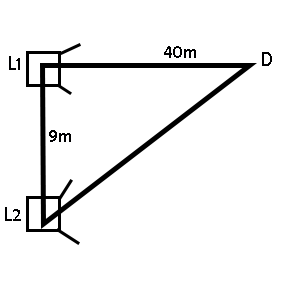Propagation Of Sound Wave MCQ - Practice Questions with Answers
Quick Facts
-
Propagation of sound wave is considered one of the most asked concept.
-
18 Questions around this concept.
Solve by difficulty
The loudspeakers L1 and L2 driven by a common oscillator and amplifier, are set up as shown in the figure. As the frequency of the oscillator increases from zero, the detector at D recorded as a series of maximum and minimum signals. What is the frequency at which the first maximum is observed? (Speed of sound = 330 m/s)

A sound source emits sound waves in a uniform medium. If energy density E and the maximum is $V_{\max }$. The plot between E and $V_{\max}$ is:
Concepts Covered - 1
Propagation of sound waves
Sound is a longitudinal wave that is created by a vibrating source such as a guitar string, the human vocal cords, or the diaphragm of a loudspeaker. As a sound wave is a mechanical wave, so, sound needs a medium having properties of inertia and elasticity. To understand the propagation of sound waves. let us take an example -
Consider a tuning fork producing sound waves. When prong B moves outward towards the right it compresses the air in front of it and due to compression, the pressure in this region rises slightly. The region where pressure is increased is called a compression pulse and it travels away from the prong with the speed of sound.


Now, after producing the compression pulse, prong B reverses its motion and moves inward. This process drags away some air from the region in front of it, which causes the pressure to dip slightly below the normal pressure. This region is a decreased pressure region which is called a rarefaction pulse. Following immediately behind the compression pulse, the rarefaction pulse also travels away from the prong with the speed of sound. If the prongs vibrate in SHM then the pressure variation in the layer close to the prong also varies simply harmonically and shows SHM hence increase in pressure above normal value can be written as -
$$
\delta P=\delta P_0 \sin \omega t
$$
Here, $\delta P_0$ is the maximum increase in value above the normal value
Now, the equation can also be written as -
$$
\delta P=\delta P_0 \sin [\omega(t-x / v)]
$$
where, $v$ is the wave velocity, So, the above equation shows the variation of pressure with time.
If the change in pressure is not very small then we can write the variation of pressure in the form of -
$$
\Delta p=\Delta p_{\max } \sin [\omega(t-x / v)]
$$
Study it with Videos
"Stay in the loop. Receive exam news, study resources, and expert advice!"

